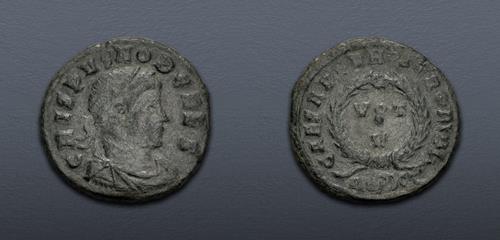
|
Crispus. Caesar, AD 316-326. Æ Follis (18.5mm, 2.82 g, 12h). Rome mint, 3rd officina. Struck AD 320-321. VF.
Electronic Auction 543
Lot: 496. Estimated: $ 150
Roman Imperial, Bronze
Sold For $ 120. This amount does not include the buyer’s fee.
Go to Live
|
|
Crispus. Caesar, AD 316-326. Æ Follis (18.5mm, 2.82 g, 12h). Rome mint, 3rd officina. Struck AD 320-321. Laureate, draped, and cuirassed bust right / VOT/ V/ in two lines within wreath with large central jewel; R(Єpω)CT. RIC VII 229. Dark green patina. VF. Very rare.
From the J. Okun-Dubitsky Collection.
This coin belongs to a very small series, all of whose issues are rare, which bear a peculiar mint mark. The mint mark spells out the Greek word eros meaning romantic love. The Latin equivalent of this word is Amor which is an anagram for Roma. The Roma-Amor anagram was well known in the time in which this issue was struck and features in the contemporary Latin palindrome “Roma tibi subito motibus ibit amor” - “Rome, love will come to you suddenly, with violence.” This saying has been attributed by some to Sotades the obscene of Maronea (circa 275 BC) and was reportedly uttered by Marcus Fabius Quintillianus (circa AD 39-95). However, the evidence for these attributions is tenuous and it is more likely that it was inspired by Sotades’ works and emerged as the famous palindrome sometime later.
The Roma - Amor couplet has also been discovered in Pompeiian graffiti in use as a magic square (K. Stanley, 239). Additionally, the wordplay is evident in a dual temple to Venus and Rome on the Velia which began construction under Hadrian in AD 121 and was ultimately dedicated by Pius in AD 136-7 (Ibid).
But perhaps most interestingly, “according to the Servian commentary on Aeneid 1.277, the existence of a ritual name of Rome had been discussed by Varro, who recorded the execution of Q. Valerius Soranus for revealing the secret. Pliny (NH 3.65) and Solinus (1.4-6) repeat the story, adding that a cult of Diva Angerona was propagated to instill silence on the subject: the goddess was represented with a bandage over her mouth. Plutarch (Quaest. Rom. 61) combines this tradition with information, probably derived from Valerius Flaccus, on the secret tutelary goddess of Rome and the rite of evocation, the formula used to induce the protective gods of a city under siege to abandon it, with a promise to provide temples for these gods in Rome. Macrobius (Sat. 3.9) not only expands upon these details but presents what he believed to be the actual text of one such evocatio … used by the younger Scipio before the walls of Carthage in 146 B.C.” (Ibid, 238-9).
Ultimately, these rare issues feature a most interesting choice for the Rome mint-mark which features a fascinating and captivating history.
Closing Date and Time: 2 August 2023 at 12:45:00 ET.
All winning bids are subject to a 20% buyer’s fee.
|
